| المجموعات الإجتماعية |
| البحث |
| مشاركات اليوم |
 |
| هندسة وصيانة الطائرات Engineering & Aircraft Maintenance يختص بشرح منظومات الطائرة والرد على استفسارات مهندسي الطيران. راجع الفهرس من هنا |
| إضافة رد |
|
|
أدوات الموضوع |
 |
| هندسة وصيانة الطائرات Engineering & Aircraft Maintenance يختص بشرح منظومات الطائرة والرد على استفسارات مهندسي الطيران. راجع الفهرس من هنا |
| إضافة رد |
|
|
أدوات الموضوع |
| مشاركة [ 1 ] | ||||
|
||||
|
|
Unsure of the exact nature of the problem, the pilots contacted maintenance personnel at the airline's headquarters in New York to discuss the meaning of the warnings. The experts agreed to divert the A320 south towards Los Angeles where JetBlue operates a maintenance hub in the nearby city of Long Beach. As Flight 292 made a flyby of the control tower at Long Beach Airport, controllers discovered the nose gear had rotated 90° and become locked in the down position. 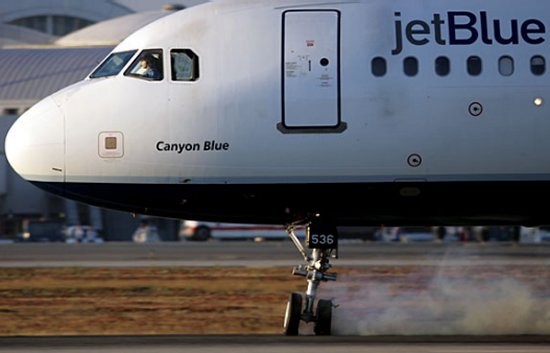 JetBlue A320 with its nose landing gear jammed As plans were made for the A320 to make an emergency landing, the plane remained in a circular flight pattern over Long Beach, Santa Catalina Island, and Newport Beach. The aircraft continued in this pattern for about three hours before attempting an emergency landing at Los Angeles International Airport (LAX). The landing was made here because of the airport's longer runways compared to Long Beach and Burbank. The flight crew and experts on the ground decided to keep the plane airborne for so long to burn off fuel. We have previously described the emergency fuel dump that many planes use to release fuel during flight prior to making an emergency landing. The purpose of this system is to lower the plane's weight so that it can land safely without risking possible damage to its landing gear and internal structure. However, these systems are typically only needed on larger commercial widebody airliners like the A340 or Boeing 747. Smaller narrow body planes such as the A320 or 737 weigh considerably less and are able to make a safe landing immediately after takeoff even when fully loaded. As a result, they are not equipped with and do not require an emergency fuel dump system. 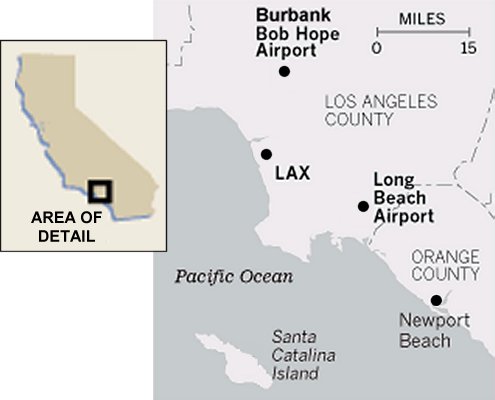 Map of the area where the JetBlue emergency occurred In the JetBlue case, however, personnel felt uncomfortable allowing the plane to land with its full load of fuel for a transcontinental flight while the nose gear was locked sideways. The plane instead remained airborne for several hours to reduce its weight until the pilots felt ready to make the landing attempt. The flight attendants also used the opportunity to move passengers and carry-on luggage toward the rear of the aircraft. This movement shifted as much weight as possible aft to minimize the load on the nose gear once the plane finally landed. The aircraft also remained flying for such a long period to give the pilots time to consult with as many experts on the ground as possible. Besides the airline's maintenance personnel, it is likely that engineers at Airbus and Messier-Dowty, manufacturer of the landing gear, were contacted to provide their input on the situation. 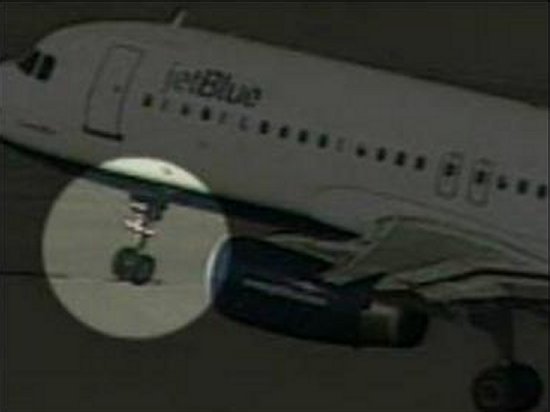 JetBlue A320 about to touch down for its emergency landing Once the decision to land had been made and emergency equipment was in place along the runway, the JetBlue pilots followed their training and gradually eased the plane onto the ground. The A320 touched down on Runway 25L at 120 knots about 2,500 ft (760 m) down the 11,000 ft (3,350 m) runway. The plane rolled along the runway on its main gear for as long as possible as its speed decreased. About 15 seconds passed before the nose of the plane finally tilted down and the nose gear touched the ground. The gear's rubber tires rapidly shredded away until the metal wheel hubs scraped the runway pavement. This friction sent up a trail of white smoke, a shower of sparks, and finally bright flashes of flame that spread behind the gear while the plane continued barreling down the runway. The pilot applied brakes at 90 knots and shut down the two turbofan engines at 60 knots. Observers became concerned about the plane's ability to stop as it continued its ground roll, but the A320 finally came to rest just 1,000 ft (305 m) short of the end of the runway. The nose gear had ground into the runway surface for about 20 seconds before the plane finally came to a halt. Once the smoke cleared, it was apparent the front wheels had been reduced to a flattened mangle of metal and rubber. The rest of the plane remained undamaged, however, and no one aboard the A320 was injured during the landing. 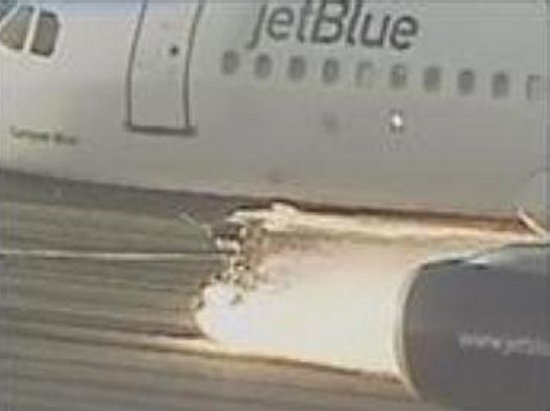 Sparks and fire from the twisted nose gear as the A320 lands The A320 involved in the emergency landing was only three-years old and had been through a routine maintenance check just five days earlier. Following the incident, the plane was moved to a Continental Airlines hangar for inspection by investigators from the National Transportation Safety Board (NTSB) and by Airbus engineers. The NTSB also removed the plane's cockpit voice recorder and the digital flight data recorder for review in Washington DC and planned to conduct a thorough review of the plane's maintenance history. Additional reports indicated the entire nose landing gear assembly might be removed and dismantled before trying to recreate the malfunction. NTSB officials estimated the investigation would last about six to nine months. This particular accident received extensive coverage because it was so well-covered by the local Los Angeles media whose news helicopters must circle the city 24 hours a day hoping to cover the next high-speed car chase. However, landing gear problems are actually relatively common and rarely result in serious damage or loss of life. Nose gear problems are the most common form of landing gear malfunctions, and pilots regularly train on how to perform an emergency landing like that conducted aboard JetBlue Flight 292. This type of landing minimizes the loads on the nose gear to reduce the potential for serious damage. Experts estimate an accident of this kind causes the nose gear to collapse and the fuselage itself to scrape along the runway perhaps 1% of the time. Even under these extreme conditions, the passengers are able to safely escape the plane and injuries are rare. What does concern experts in the field is the fact this type of landing gear problem has occurred so frequently on the Airbus A320 and related A318, A319, and A321. Although the A320 family has an excellent safety record overall, a Canadian report released in 2004 documented 67 cases of nose landing gear failures aboard the A320 series worldwide since 1989. At least seven cases involved the nose gear becoming locked at a 90° angle as occurred on JetBlue Flight 292. The A320 has never been grounded as a result of these accidents because none has resulted in injury and Airbus has made several improvements to the nose gear design. 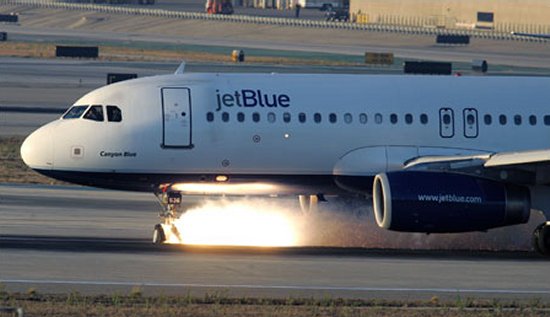 JetBlue A320 during its emergency landing The nose gear is controlled by a computer that sends commands to an electrical system. This system in turn operates hydraulics that retract and deploy the gear. The failure aboard JetBlue Flight 292 could have resulted from a malfunction in any one of these systems or other mechanical components of the landing gear. A hydraulic problem had caused a similar malfunction on an America West flight in 1999. The flaw was blamed on a faulty valve seal that was already known because of an earlier nose gear failure. Airlines flying the A320 had been alerted about a repair, but the fix had not yet been implemented on the America West aircraft. The Federal Aviation Administration (FAA) then issued a mandatory order to complete this fix on all A320 series planes in the United States. The same type of nose gear failure also occurred in four other cases, including two foreign aircraft and another JetBlue flight to New York in November 2002. A United Airlines flight to Chicago had to make an emergency landing due to the same problem just three weeks later. In all four cases, the fault was blamed on improper installation of a hydraulic shock absorber. Both US incidents had occurred shortly after the planes underwent maintenance, and the FAA issued advisories to the airlines warning about incorrect maintenance procedures that could result in the failure. The French landing gear manufacturer Messier-Dowty had redesigned the backplate onto which the shock absorber is attached to prevent future occurrences of the problem, but the redesign was still awaiting approval as of April 2004. It is unknown whether the new part had been approved or installed on the JetBlue A320 involved in the most recent incident. 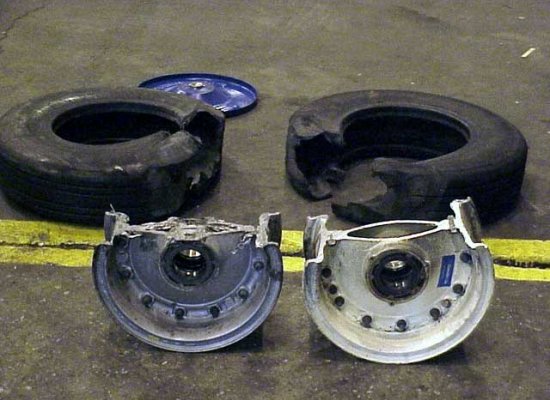 Damaged A320 wheels removed from the JetBlue plane Readers wanting to learn more about landing gear design should check out Aircraft Landing Gear Design: Principles and Practices by Norman Currey. Those interested in aircraft accident investigations might want to look at Shari Krause's Aircraft Safety: Accident Investigations, Analyses, & Applications or Aircraft Accident Analysis: Final Reports by Robert Sumwalt and Jim Walters. Another good book on airline safety and regulations is Commercial Aviation Safety by Alexander Wells and Clarence Rodrigues. - answer by Jeff Scott, 2 October 2005 |
|||
|
|

|
| مشاركة [ 2 ] | ||||
|
||||
|
|
الله يعطيك العافية
مع التحيه |
|||
|
|

|
| مشاركة [ 3 ] | ||||
|
||||
|
|
awesome report !
could u plz tell me were u got it from ? thanks alot |
|||
|
|

|
| مشاركة [ 4 ] | ||||
|
||||
|
|
أخواني الأعزاء شكراً لكم علي المرور
تقبلو خالص تقديري لكم Prather captain-Ahmed I got it from https://www.amazon.com/exec/obidos/AS...rospacewebo-20  |
|||
|
|

|
| مشاركة [ 5 ] | ||||
|
||||
|
|
مـــــــــــــــــــــشـــــــــكورين أخواني
|
|||
|
|

|
| مشاركة [ 6 ] | ||||
|
||||
|
|
شكراً لك كابتن طارق اختيار متميز تابعت هذا الحادث لحظة بلحظة |
|||
|
|

|
| مشاركة [ 7 ] | ||||
|
||||
|
|
التميز من الكابتن واضح
اسال الله تعالى له المزيد من التوفيق وبطبع خط الطيران دائما في المقدمة بجهودكم |
|||
|
|

|
| مشاركة [ 8 ] | ||||
|
||||
|
|
مشكور اخي العزيز كابتن طارق على الموضوع
نشاط متميز ..... بارك الله فيك مزيدا من التألق |
|||
|
|

|
| إضافة رد |
 هندسة وصيانة الطائرات Engineering & Aircraft Maintenance
هندسة وصيانة الطائرات Engineering & Aircraft Maintenance
|
|
|
|
|
|
 المواضيع المتشابهه
المواضيع المتشابهه
|
||||
| الموضوع | المنتدى | |||
| الخطوط الجوية اليمنية تؤكد شراء عشر طائرات أيرباص A320 | المقالات الصحفية Rumours &News | |||
| مغلق لعدم توفر روابط حقيقيه: الأن و حصريا و قبل الجميع , الطائرة العملاقة A320 air sammir جاهزة للتحميل | Flight Simulator 2004 | |||
| Saudi Arabian Airlines receives first directly bought Airbus A320 | المقالات الصحفية Rumours &News | |||
| إيرباص تسلم طائرة A320 الى الخطوط الجوية العربية السعودية | المقالات الصحفية Rumours &News | |||
| Airbus A320 Video Training | دروس خط الطيران | |||